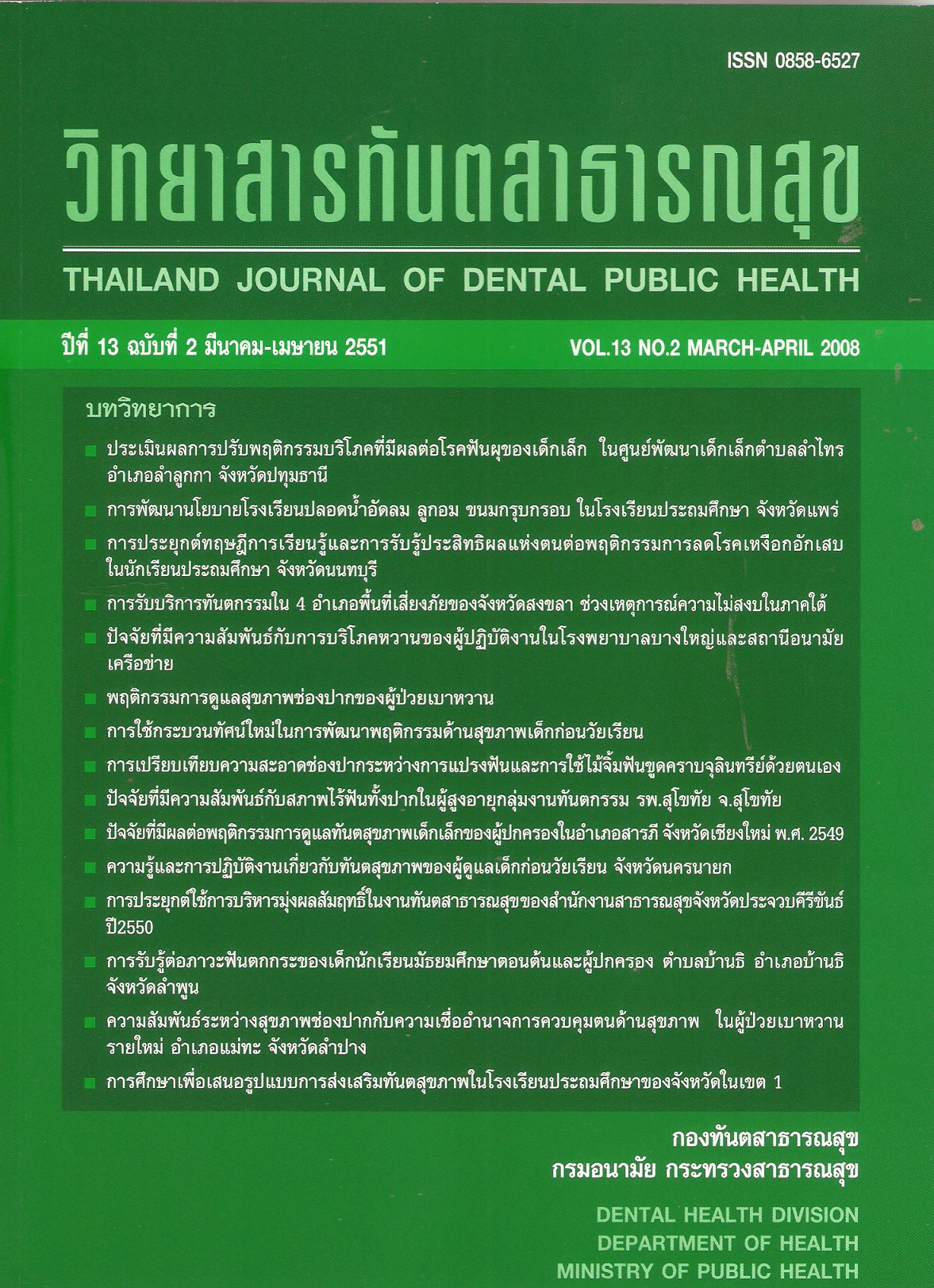The Study of Oral cleanness Between Tooth brushing and Tooth pick plaque scaling.
Main Article Content
Abstract
Daily tooth brushing left large amount of plaque, increased chance to make oral disease. Toothpick was the first oral cleansing device, easy to find, cheap price. Everyone could use toothpick to clean oral cavity, to improve oral cleanness. The objectives of this study were to compare oral cleanness after tooth brushing and tooth picking in 20 primary school students. Everyone received scaling, polishing, 2 weeks brushing, 2 weeks tooth picking, chewing disclosing tablet and plaque examination. Tooth brushing and tooth picking had residual plaque at lower teeth more than upper teeth and the most at lingaul side of lower teeth. Tooth brushing showed continuous band of residual plaque less than 1 millimeter at cervical area of tooth surface. Tooth picking showed discrete residual plaque at cervical area and proximal tooth surfaces. Plaque residual after tooth brushing and tooth picking were difference statistically significance (MannWhitney test, P=0.01). Tooth brushing showed 3 clean teeth (0.71%) and tooth picking showed 83 clean teeth (19.76 %). Regular tooth brushing and tooth picking could be done in real-live, sustained for invidual level and community level, and increased chance for everyone to fully participate in oral health promotion and prevention.
Downloads
Article Details
References
2. Bowen. W.H., Nature of plaque. Oral Sci.Rev. 1976, 9: 3-5
3. Loe. H., A Review of the prevention and control of plaque. Interdental plaque. Mchegh. W. D. London, E and S Livjnton Ltd. 1970, 259-270
4. Loe. H., Theilads. F., Jansen. Experiment Gingivitis in Man. Journal of Periodontology 1965, 36: 177-187
5. Green. J. C. Oral Health Care for the Prevention and Control of Periodontal Disease. Review of literature. Ann Arbor. Mich: World work shop of periodontic. 1966: 415
6. Schei. O., Wearhaug. J., Lovdal. A. and Arno. A. Alveolar Boon Lose as Related to Oral Hygiene and Age. J. Periodontol. 1959. 30; 7-16
7. Genco. R. J. Progress in periodontal research. Funding from the Periodontal disease Clinical Research Center. State University of New York at Buffalo. Northeast Soc. Periodontis. Bull. 1984. 11, 5-4
8. Woodward M. Sugar consumption and dental caries evidence from 90 countries. Br. Dent. J. 1994: 176: 297-302
9. อุทัยวรรณ กาญจนกามล อัญขลี ดุษฎีพรรณ์ จิรวรรณ คงมาลัย และ อนุศักดิ์ คงมาลัย การศึกษาประสิทธิภาพของไม้ข่อยและไม้สีฟันคนทา ในโครงการอนามัยช่องปากของเด็กไทยในชนบท 2527. 17-20
10. Weinberger. B. W. An introduction to the History of Dentistry. Vol. 1: 398 St Louis C. V. Mosby
11. Lang. N. P., Cumming. B. R., Loe. H. Tooth brushing frequency as it Relates to Plaque Development and Gingival Health. 1973, 44, 396-405
12. De la Rosa, M.R., Guerra,J.Z., Johnstone, D. A., Plaque Growth and Removing with Daily Tooth brushing. J. Periodontol. 1979; 50 : 661
13. Bergenholtz, A., Bjorn A., Vikstom. B. The Plaque Removing Ability of Some Common Interdental Aids. An intra – individual study. J. Clin. Periodont. 1974; 1 : 160
14. Stand lee. M. W. The Blessed Twig. Military Medicine. 1960, 125 : 689-703
15. Coontz. E. O. The effectiveness of a new oral hygiene device on plaque removal. Ouintessence Int. 1983, 14:1
16. กมล เลาหกุล และคณะฯ ความเป็นไปได้ใน การจัดกิจกรรมการขูดคราบจุลินทรีย์ด้วยตนเอง ในโรงเรียนประถมศึกษาจังหวัดลําพูน 2539-40, 10-12
17. World Health Organization (WHO) Periodontal Disease. Geneva;: WHO Technical Report Series No. 207, 1961


